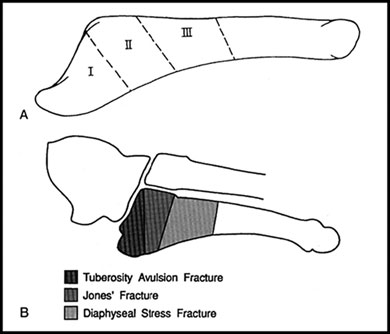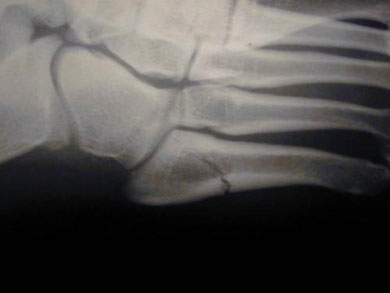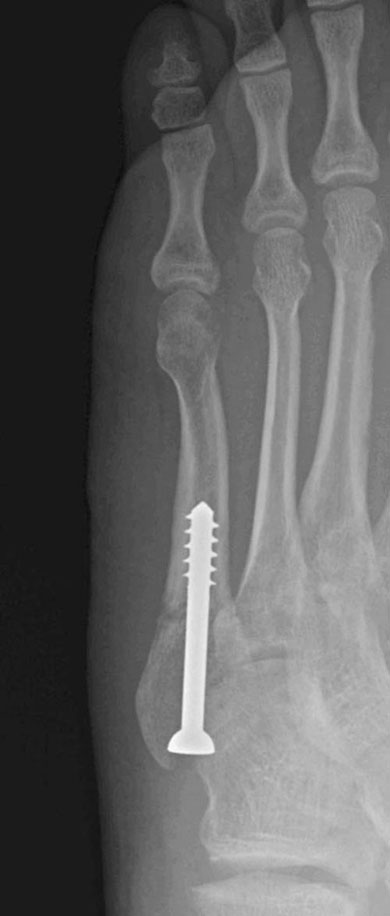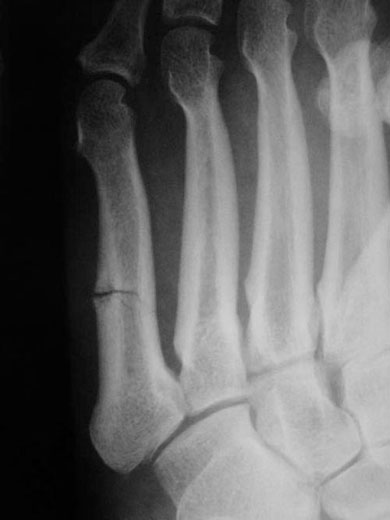How Do You Treat Proximal Fifth Metatarsal Fractures?
There are 3 distinct fracture patterns that affect the base of the fifth metatarsal. Unfortunately, the terminology and descriptions of these injuries remain confusing in the orthopedic literature. Diagnostic clarity is critical as it dictates treatment recommendations and prognosis.
Quill1 reported a classification of fifth metatarsal base fractures based on 3 zones (Figure 36-1). Zone I fractures occur through the tuberosity and are considered avulsion injuries. Zone II fractures are more distal and extra-articular (relative to the tarsometatarsal joint) and traverse the 4-5 intermetatarsal articulation. Fractures in the proximal portion of the diaphysis are considered Zone III. Sir Robert Jones’ original description involving 4 cases, including his own, were acute fractures in the Zone II region.2

Figure 36-1. Zones and fracture patterns of the fifth metatarsal base.
The most common fracture of the fifth metatarsal base is an avulsion of the tuberosity. Although originally thought to be caused by overpull of the peroneus brevis tendon when the foot supinates or adducts abruptly, literature has supported the notion that the lateral band of the plantar fascia is the primary cause.3 I treat the vast majority of tuberosity fractures in a hard-soled shoe or short Controlled Ankle Movement boot with full weight bearing permitted. The more symptomatic patients with lower pain tolerances typically do better with the walker boot. Patients are encouraged to transition to regular shoes as soon as they feel comfortable, which is usually 3 to 4 weeks after the injury. I do not routinely obtain follow-up radiographs because fibrous unions are common, are usually asymptomatic, and do not change my treatment recommendations.
Occasionally, I will see a patient with a large Zone I tuberosity avulsion that involves a significant amount of the joint surface. If substantial joint displacement is noted (more than 2 to 3 mm), I will consider open reduction and internal fixation. Computed tomography is very helpful in evaluating the extent of the joint involvement and displacement if plain films are equivocal. For these relatively uncommon variants, I use a small fragment screw placed obliquely through the tuberosity and across the medial cortex of the proximal fifth metatarsal in lag fashion. A partially threaded cannulated 4.0-mm screw with a washer works well. I expose the fracture through a longitudinal incision centered on the dorsal aspect of the tuberosity and place the screw percutaneously. Postoperatively, I keep these patients nonweight bearing for the first 2 to 3 weeks in a splint, and then advance to protected weight bearing in a cast or boot until 6 weeks after surgery.
A true Jones fracture is an acute injury that occurs in Zone II of the fifth metatarsal base (Figure 36-2). Treatment for these fractures is controversial. Nonoperative treatment in a nonweight-bearing short leg cast has been the traditional treatment4 and is still widely practiced. Clapper et al5 reported average time to healing of 21 weeks and a 28% nonunion rate from a series of 25 patients with a true acute Jones fracture. I favor the use of a walker boot, and permit weight bearing as tolerated in patients who choose to avoid surgery. Anecdotally, we have not appreciated a higher nonunion rate with this approach compared to nonweight bearing in a cast. For most cases, however, I offer operative treatment to the patient. The surgery is relatively simple with low morbidity and it facilitates faster and higher union rates with a more aggressive rehabilitation. Most practitioners recommend surgical intervention in all high-performance athletes, but I apply this to any patient who desires a more reliable, shorter healing period, albeit with the risk of surgery.

Figure 36-2. Acute Zone II Jones fracture.
For patients electing surgery for an acute Jones fracture, I recommend percutaneous intramedullary screw fixation. The procedure can be performed under an ankle block as an outpatient. A guide-pin is placed under fluoroscopy through a small incision. The starting point is critical to optimize screw placement. A “high and inside” starting location on the base of the fifth metatarsal facilitates maintaining an intramedullary screw position with avoidance of cortical break-out in a bone with curved morphology. I use a cannulated entry system but place a solid, partially threaded screw, usually 4.5 or 5.5 mm in diameter. Ideal screw length is just long enough for the threads to be distal to the fracture (Figure 36-3). Typically, the screw traverses about half of the metatarsal length. I do not routinely bone graft the acute Jones fractures. Postoperatively, patients are nonweight bearing in a splint for 2 weeks, then full weight bearing in a walker boot until 6 to 8 weeks postoperatively. Activity is progressed based on symptoms and radiographic healing. Return to full activity, including sports, may take up to 3 months.

Figure 36-3. Appropriate intramedullary screw position with ideal screw length.
Zone III injuries in the proximal diaphysis of the fifth metatarsal are typically stress fractures (Figure 36-4). Patients often report prodromal symptoms, but radiographic findings are variable. Torg et al have classified these as acute or chronic.6 Acute fractures are typically characterized by a radiolucent line with sharp margins and minimal bone hypertrophy. Chronic stress fractures, including delayed and nonunions, typically demonstrate a widened lucent line with resorption, intramedullary sclerosis, and periosteal reaction. Acute proximal diaphyseal stress fractures are treated similar to acute Jones fractures, and expectedly are equally controversial. Nonweight bearing in a short leg cast is an accepted treatment, although I will typically allow weight bearing in a walker boot and add the use of an external bone stimulator.

Figure 36-4. Zone III diaphyseal acute stress fracture.
Depending on the patient’s preferences and goals, I favor intramedullary screw fixation for acute and chronic Zone III stress fractures. It is critical to assess hindfoot alignment, and varus position is a contributing factor both in terms of etiology and recurrent fractures. I will add a hindfoot osteotomy in severe cases, or if the patient has failed previous screw fixation. The percutaneous technique for screw fixation is the same as noted for Jones fractures. For nonunions and delayed unions, I will also make a small incision over the fracture site and débride the bone and fibrous tissue. The defect is then packed with autograft, usually a small dowel of bone from the calcaneus or iliac crest. Postoperative protocol includes nonweight bearing for 2 weeks in a splint, followed by protected weight bearing in a walker boot until 6 to 8 weeks after surgery. For high-risk cases (ie, revision surgery or nonunions), I also use an external bone stimulator and the rehabilitation process is less aggressive.
Conclusion
It is critical that any fracture of the fifth metatarsal base is appropriately assessed in terms of both location and chronicity. Prognosis and treatment is vastly different for the many variants, and an understanding of the classification will facilitate appropriate management.
References
1. Quill GE. Fractures of the proximal fifth metatarsal. Orthop Clin North Am. 1995;26:353-361.
2. Dameron TB. Fractures and anatomical variations of the proximal portion of the fifth metatarsal. J Bone Joint Surg Am. 1975;57:788-792.
3. Richli WR, Rosenthal DI. Avulsion fracture of the fifth metatarsal: experimental study of pathomechanics. Am J Roentgenol. 1984;143:889-891.
4. Rosenberg GA, Sferra JJ. Treatment strategies for acute fractures and nonunions of the proximal fifth metatarsal. J Am Acad Orthop Surg. 2000;5:332-338.
5. Clapper MF, O’Brien TJ, Lyons PM. Fractures of the fifth metatarsal: analysis of a fracture registry. Clin Orthop. 1995;315:238-241.
6. Torg JS, Balduini FC, Zelko RR, Pavlov H, Peff TC, Das M. Fractures of the base of the fifth metatarsal distal to the tuberosity: classification and guidelines for non-surgical and surgical management. J Bone Joint Surg Am. 1984;66:209-214.
